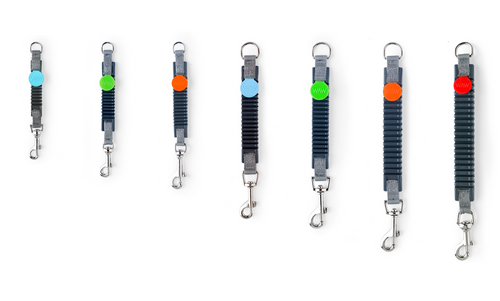The WAW Pet bungee piece is something completely different from what you're used to!
When outdoors, both the dog and the handler are exposed every single day to tens or even hundreds of leash jerks. Some jerks are smaller – and the worst ones can cause significant damage. Even small jerks can be very deceptive: imagine a situation where the owner walks ahead of the dog and the dog suddenly stops to sniff the ground – perhaps turning back and jerking. This causes a sudden pull backward on the handler's hand and shoulder, which can easily cause tissue or tendon injury without much force.
Repeated tens of thousands of small tugs over the years have been proven to cause micro-injuries to the dog's cervical spine, not to mention the damage caused by bigger lunges. Especially the soft tissue structures of puppies in their developmental phase often endure unnecessary strain during leash training. If you could reduce the occurrence of injuries, you would probably do it, right?
WAW is a bungee piece designed and manufactured in Italy that significantly dampens tugs and can be attached to any normal leash. WAW is made of a sturdy plastic composite that withstands both time and wear. WAWs are available in different sizes, so it suits all dogs from just a couple of kilos to giant breeds.

How does WAW differ from traditional rubber band bungee?
Many dog owners have tested traditional rubber band bungee pieces or leashes in everyday use, and many have also forgotten them in the back of a cupboard because walking the dog has become uncontrollable “yo-yoing.” The dog has been able to stretch out, for example, towards other dogs and onto the bike path. With a longer bungee (and looser than WAW) rubber band piece, it is difficult to gauge how far the dog can advance. Also, with an elastic rubber band, the dog can stretch it to its full length, after which the dog's neck experiences a snap back when the rubber band recovers. One dog owner even said they sometimes had to dodge their own dog, which after brisk sprints flew back to the walker's feet due to the rubber band's recovery movement.
Many who have tested traditional bungee pieces also note that the dog pulls more with the bungee. This feeling often comes from the fact that the dog can indeed pull a somewhat loose rubber band to its full length and, if desired, keep it there, so in the end the walker is the one who has to use force to slow down the rubber band's recovery phase. This easily creates the feeling that the dog pulls harder.
So how does WAW differ from rubber band bungee? WAW is made of a flexible plastic composite: its bungee is clearly stiffer than rubber band bungees and the stretch distance is shorter, so there is no similar stretching and snapping back. Control over the dog remains the same as with a non-elastic leash. WAW's short, firm bungee still dampens most of the tug force. WAW is at its best in damping sudden stops and strong tugs.
- WAW has progressive (= gradual) bungee, which guarantees damping that strengthens with the pull. When the dog tugs, WAW stretches the rubber band slowly and returns slowly to its shape when the pull ends.
- The WAW plastic composite material does not lose its elasticity in use like rubber bands. So it is a durable choice!
- WAW does not absorb water, so it is lightweight even when wet.
- You notice WAW's "brilliance" from the fact that you practically don't pay attention to its function. The difference is clear if you leave WAW out after a moment of use: the jerks feel really unpleasant both for yourself and the dog.
If you tried to achieve the same firmness with a rubber band, the product would probably become very heavy, and gradual bungee could not be realized.

How do the WAW Basic and WAW Sport models differ?
Several Italian Sled dog sport top athletes have been involved in the development of WAW. The Basic and Sport models differ only in the carabiner/no carabiner aspect; the function is exactly the same. In Sled dog sport competitions (canicross, bikejoring, etc.), the line must not have metal parts on the athlete's side, so the Sport model is made carabiner-free. In addition to the Basic model, the Sport model is also great for everyday use.

The WAW Sport model has been used, for example, by multiple Sled dog sport World Champions like Igor Tracz, whose comments can be seen here video. Competitors using WAW Sport say that the feel of the dog's movements is more precise, and traditional rubber bands "eat" that feel. With WAW, for example, cornering at high speed is more precise. Many also appreciate the lightness: you can combine WAW with a very light rope.
WAW is also a friend for those using flexi, both in everyday life and when hiking
The risk of serious jerk injuries increases as the leash length increases. With a reel leash or a long trailing line, the dog can accelerate to a high speed, for example, when seeing a hare, before the handler can react. When the leash length runs out, the jerk is often very strong. WAW is therefore an excellent addition even to longer leashes.
When hiking with a dog, and especially when moving with, for example, touring skis, a handy combination is a canicross belt (e.g. Non-stop Loype Belt Pro), flexi, and WAW. We especially recommend this combination when the dog must be leashed, but you need more distance between you than a normal elastic Pull line allows.
In summary then
- WAW is suitable for dogs of all sizes (sizes XXS-XXL)
- WAW protects both the dog and the handler from sudden jerks
- WAW is lightweight and discreet
- WAW maintains control over the dog
- WAW is compatible with both normal leashes and flexi
- WAW is durable and made in Europe!
Click here for WAW products:


